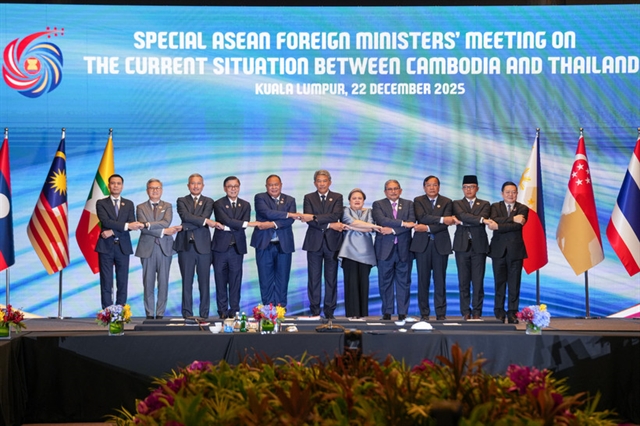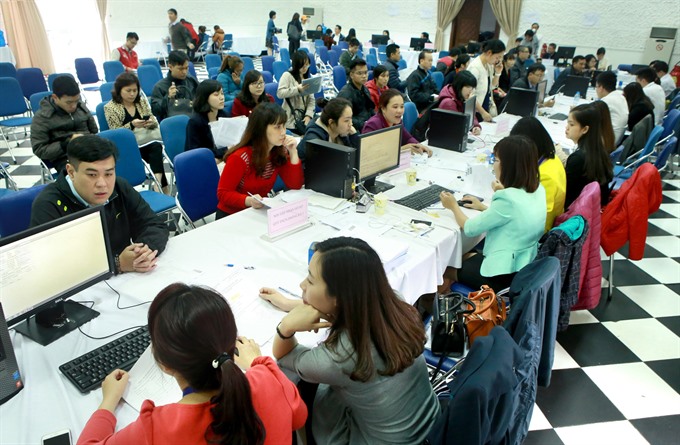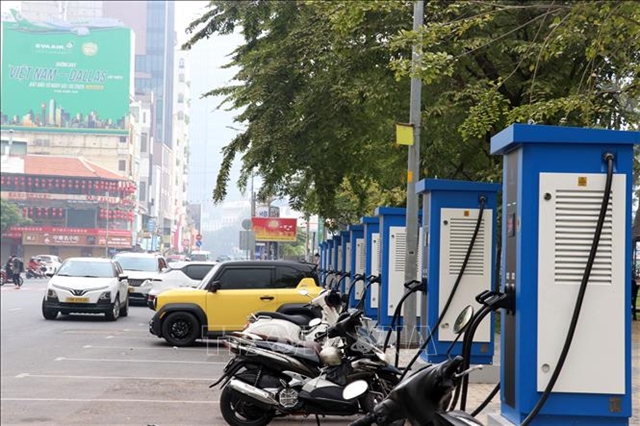 Politics & Law
Politics & Law

Deputy Prime Minister Trương Hoà Bình has urged ministries, sectors and localities to finish the build-up and promulgation of the e-Government architecture framework at ministerial and provincial levels before September this year, as Việt Nam is determined to accelerate the formation of the e-Government.
 |
| Tax officials (on the right side of the tables) receive personal income tax finalisation documents from Hà Nội residents. The Vietnamese Government aims to considerably increase the number of administrative procedures processed via electronic systems in the near future. — VNA/VNS Photo Hoàng Hùng |
HÀ NỘI — Deputy Prime Minister Trương Hoà Bình has urged ministries, sectors and localities to finish the build-up and carrying out of the e-Government architectural framework at ministerial and provincial levels before September this year, as Việt Nam is determined to accelerate the formation of its e-Government.
The e-Government architectural framework displays the overall architecture of all components in the e-Government system of State bodies, their functions and correlations.
The establishment of the frameworks at different levels plays an important role in the development of e-Government systems, particularly the improvement of connectivity and data sharing among different State bodies.
According to the Deputy PM’s recent request, all IT projects or plans to rent IT services of State bodies from 2018 onwards should meet the requirement of inter-level or inter-sectoral connectivity, integration and data sharing.
Electronic systems being developed to process administrative procedures should comply with the e-Government architectural framework at ministerial and provincial levels, once they are approved.
Ministries, ministerial level bodies and central-level provinces and cities are being asked to continue simplifying administrative procedures and issue uniform regulations of administrative procedures to further expand the application of online public service levels 3 and 4.
Level 4, the highest level of online public services, as defined by the Government, allows people and businesses to perform administrative procedures online, including the filling out of forms, submitting of forms and payments, while transaction results are available either online or by post, upon request. Meanwhile, level 3 means every task except payments can be done online.
Ministries, ministerial level bodies and central-level provinces and cities are also asked to incorporate current applications for public services into one uniform application for each ministry or locality.
The Ministry of Information and Communication (MIC) is being asked to speed up the completion of the National Government Service Platform and instruct other ministries, sectors and localities to connect and integrate data through this platform.
Steady progress
After a resolution on e-Government, which was issued by the Government in 2015, steady progress on the creation of e-Government has been witnessed across the governmental spectrum with many ministries, State agencies and local authorities proactively applying IT in their operation and in offering public services.
According to the 2017 white book on IT and communication issued by MIC, as of 2016 the number of online public services reached 109,644, in which services at level 3 and 4 accounted for nearly 10 per cent and 1.3 per cent, respectively.
A recent report by the Government Office showed, in the last three months of last year, many ministries, sectors and localities, such as the Ministry of Industry and Trade and Ministry of Science and Technology had opened online portals for public services to meet the commitment of administrative reforms.
Statistics showed that in 2017 a great number of dossiers submitted by people and businesses were performed through online public services level 3 and 4. For example, over 8.8 million dossiers were processed online by the Ministry of Public Security, nearly 772,000 dossiers by the Ministry of Industry and Trade and more than 225,000 by Hà Nội authority.
The Government Office has planned to publish the list of public services level 3 and 4 offered by ministries, sectors and localities in 2018 in April this year.
Large cities and provinces, including Hà Nội, HCM City, Đà Nẵng or Bình Dương, have also rolled out plans to become smart cities, with a focus of further encouragement of IT application in governance. — VNS




